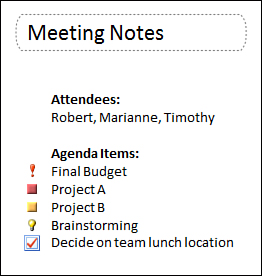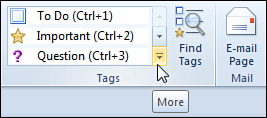You might have seen tags on websites
before, where they are often used on blogs and news sites to group
similarly themed content into categories. By clicking the category tag,
you can quickly see a list of content that’s available in that
category. Tags have many other, similar uses. For example, when you
import photos from your digital camera into an image-editing program,
it may let you apply tags to your photos to describe what appears in
them (the tags would consist of keywords like landscapes, pets,
children, and so on) before the pictures are added to your collection.
As your photo album grows to hundreds or perhaps thousands of pictures
down the road, it would become increasingly harder to find, say, all of
your pictures of your dog. By using tags to categorize and search for
files, you can quickly locate and display all of the items that are
associated with a particular tag.
Tags can also be used to indicate the priority of an
item. In Microsoft Outlook, for example, using the Important or Low
Priority markers for the e-mail messages that you send is a useful way
of tagging the priority of the content in such messages, thus making it
easier for the recipient to decide which items require immediate
attention and which ones can wait.
In OneNote, tags are an optional way for you to
categorize and prioritize selected notes, and you can also use note
tags to aid in quickly locating and displaying specific, important
information again whenever you need it. Before you get to OneNote’s
powerful search features, however, take a closer look at using tags.
In OneNote, a tag consists of an icon that will appear next to your notes text to mark the note (see Figure 1).
Each tag also has a description that indicates its category or purpose
(for example, Important, Idea, Client Request, and so on).

For example, if you tag all of the distinct ideas
that come up during a brainstorming session with your team, it’s much
easier to scan your notes and look for the lightbulb icon that
represents the Idea tag. To see the descriptive name of a tag, move the
mouse pointer over the tag’s icon once it has been applied to a part of
your notes.
Applying a Tag to a Note
To apply a tag to a note, follow these steps:
1. | Open or create a page with a couple of paragraphs of notes.
|
2. | Click the first line of any paragraph of text on the page. This lets OneNote know which paragraph you want to tag with an icon.
|
3. | On
the Home tab, in the Tags group, click the yellow star icon that is
labeled “Important.” OneNote places the yellow star icon in the left
margin of the current paragraph. If you move the mouse over the star
icon, a ToolTip appears to let you know that this is the note tag for
indicating important notes.
|
To see all available tags in OneNote, click the Home
tab and then, in the Tags group, click the small downward-facing arrow
at the bottom of the tags list box. A ToolTip will say “More” if you
hover over this arrow (see Figure 2).
When you click this button, OneNote displays the full collection of
available note tags and reveals the command for customizing your own
tags.

Tagging isn’t just reserved for typed text. You can
tag handwritten notes, inserted files and printouts, pictures, screen
clippings, scanned images, and any other objects that you’ve placed on
your notes page.
|
Though tagging your notes is entirely optional, it’s
quite useful in a variety of situations, depending on how you collect
and then want to use the information in your notebooks. You can use
tags to flag important notes for follow-up (for example, the action
items assigned to you in a meeting). You can also use tags to
categorize information in your notes (for example, to identify all of
the ideas during brainstorming and all the questions that have been
asked about them). Finally, you can also use tags to identify multiple
projects that are associated with specific follow-up items or reminders
and list these in separate or combined to-do lists. OneNote does all
the work, leaving you to spend your time focusing on your notes and
information, your thoughts and ideas, instead of flipping through all
of your pages, trying to find specific information in your notebook.
Applying tags and the ability to fully customize these tags is yet
another way in which OneNote beats paper notebooks every time.
|
Using the To Do Tag
Though most note tags in OneNote 2010 are static
icons, there is one tag that’s interactive—the To Do tag. Initially, it
appears as a blank check box, but you can click this box to place a
check mark in the box to indicate that a task has been completed.
The To Do tag is best applied to follow-up
reminders, such as action items that were assigned to you during a
business meeting, things your teacher told you to study for your next
test, or the chores you’ve been assigned at home.
To create a to-do list with this tag,
insert the To Do tag at the beginning of every line item in your list
and then click the items you have completed. When all of the items on
your list have been completed, you can delete the list from your
notebook, or you can keep it as a record of your accomplishments.